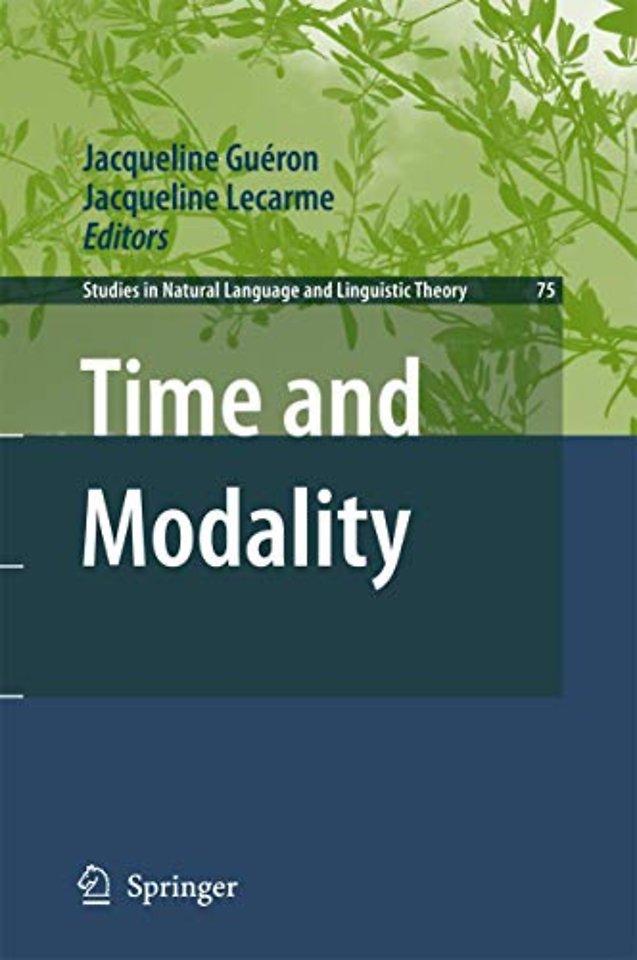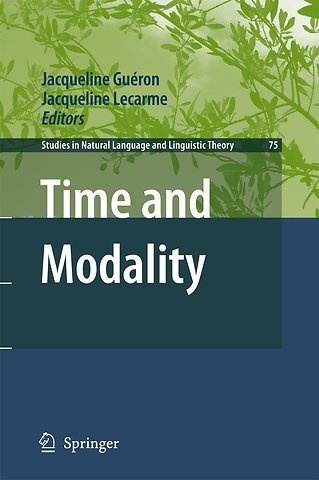Time and Modality
Paperback Engels 2010 9789048178537Samenvatting
The papers in this volume were ?rstpresented at the International Round Table Time and Modality held in Paris in December of 2005 and organized by the Jeune ´ Equipe B 368 Syntaxe anglaise et syntaxe comparative (Universite ´ Paris3-Sorbonne Nouvelle) and by the Laboratoire de Linguistique Formelle (Centre National dela Recherche Scienti?que (CNRS) and UniversiteP ´ aris 7). We wish to thank the institutions that provided ?nancial support for the Round Table: the CNRS, the Laboratoire de Linguistique Formelle,the Conseil Sci- ti?que(Universite ´s Paris3 and Paris 7) and the Bureaudes Relations Internationales (UniversiteP ´ aris3). vii Contents Preface . . . . . . . . . . . . . . . . . . . . . . . . . . . . . . . . . . . . . . . . . . . . . . . . . . . . . . . . . . . . vii Contributors . . . . . . . . . . . . . . . . . . . . . . . . . . . . . . . . . . . . . . . . . . . . . . . . . . . . . . . xv Introduction . . . . . . . . . . . . . . . . . . . . . . . . . . . . . . . . . . . . . . . . . . . . . . . . . . . . 1 1Tense . . . . . . . . . . . . . . . . . . . . . . . . . . . . . . . . . . . . . . . . . . . . . . . . . . . 2 2Aspect . . . . . . . . . . . . . . . . . . . . . . . . . . . . . . . . . . . . . . . . . . . . . . . . . . 3 2. 1 Perfectand Perfectivity . . . . . . . . . . . . . . . . . . . . . . . . . . . . . 3 2. 2 Eventuality Type . . . . . . . . . . . . . . . . . . . . . . . . . . . . . . . . . . 4 3 Modals and Modal Verbs . . . . . . . . . . . . . . . . . . . . . . . . . . . . . . . . . . . 5 3. 1 Subject/Speaker Orientation . . . . . . . . . . . . . . . . . . . . . . . . . 5 3. 2 The Temporal Location of Modal Verbs . . . . . . . . . . . . . . . 6 3. 3 The Temporal/Causal Function of Modal Verbs . . . . . . . . 7 3. 4 The Temporal Syntax of Non-Root Modals . . . . . . . . . . . . 8 3. 5 Weak Necessity Modals . . . . . . . . . . . . . . . . . . . . . . . . . . . . 9 4 The Role of Past Morphology in Modal Contexts . . . . . . . . . . . . . . . 9 5 The Subjunctive . . . . . . . . . . . . . . . . . . . . . . . . . . . . . . . . . . . . . . . . . . 10 6 Genericity . . . . . . . . . . . . . . . . . . . . . . . . . . . . . . . . . . . . . . . . . . . . . . . 11 7Copular Clauses . . . . . . . . . . . . . . . . . . . . . . . . . . . . . . . . . . . . . . . . . . 11 8Conclusions and Open Problems. . . . . . . . . . . . . . . . . . . . . . . . . . . . . 12 References . . . . . . . . . . . . . . . . . . . . . . . . . . . . . . . . . . . . . . . . . . . . . . . . . . . . . 14 Patterns in the Semantics of Generic Sentences . . . . . . . . . . . . . . . . . . . . . . 17 Greg Carlson 1 The Setting . . . . . . . . . . . . . . . . . . . . . . . . . . . . . . . . . . . . . . . . . . . . . . 17 2TheIssues . . . . . . . . . . . . . . . . . . . . . . . . . . . . . . . . . . . . . . . . . . . . . . . 18 3 Induction and Stipulation . . . . . . . . . . . . . . . . . . . . . . . . . . . . . . . . . . . 22 3. 1 Rules and Induction . . . . . . . . . . . . . . . . . . . . . . . . . . . . . . . 22 3. 2 What do Generic Sentencesdo? . . . . . . . . . . . . . . . . . . . . . 23 3. 3 Inductive Generalizations Again . . . . . . . . . . . . . . . . . . . . . 24 ix x Contents 4 Patterns . . . . . . . . . . . . . . . . . . . . . . . . . . . . . . . . . . . . . . . . . . . . . . . . . 25 4. 1 Patterns and Non-Patterns . . . . . . . . . . . . . . . . . . . . . . . . . . 25 4. 2 Generic Sentences . . . . . . . . . . . . . . . . . . . . . . . . . . . . . . . . . 27 4. 3 Restriction . . . . . . . . . . . . . . . . . . . . . . . . . . . . . . . . . . . . . . .
Specificaties
Lezersrecensies
Inhoudsopgave
Rubrieken
- advisering
- algemeen management
- coaching en trainen
- communicatie en media
- economie
- financieel management
- inkoop en logistiek
- internet en social media
- it-management / ict
- juridisch
- leiderschap
- marketing
- mens en maatschappij
- non-profit
- ondernemen
- organisatiekunde
- personal finance
- personeelsmanagement
- persoonlijke effectiviteit
- projectmanagement
- psychologie
- reclame en verkoop
- strategisch management
- verandermanagement
- werk en loopbaan

